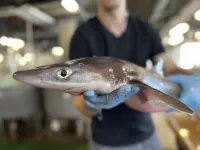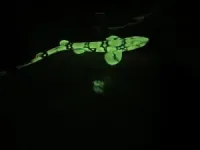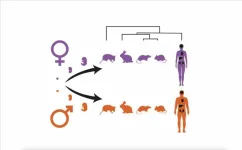(Press-News.org) By David L. Chandler
WOODS HOLE, Mass. -- Sharks differ from other fish in many ways, including an apparently remarkable ability to heal from wounds, according to reports of sharks recovering from injuries sustained in the wild. While this healing ability has not yet been documented in controlled laboratory conditions, some of the chemical compounds found in shark skin may have significant biomedical potential.
To investigate this possibility, two dermatology researchers from the Karolinska Institute in Sweden carried out research on a small shark, the spiny dogfish (Squalus acanthias) and other cartilaginous fish species at the Marine Biological Laboratory (MBL) in Woods Hole. Their goal is to understand the unique biochemistry of the skin of these animals. Previous research on sharks in other labs has led to the development of a new antibiotic, and the discovery of biochemical pathways relevant to cystic fibrosis research.
Jakob Wikström, associate professor of dermatology and principal investigator at Karolinska, and Etty Bachar-Wikström, senior researcher, investigated the skin mucus of two species of sharks and their close relatives, little skates, at the MBL. Unlike the vast majority of fish species, which have relatively smooth skin protected by a thick, slimy layer of mucus, sharks have rough skin that feels like sandpaper. It wasn’t obvious whether this skin has a protective mucus layer at all.
“Much more is known about fish biology than shark biology, for obvious reasons,” Wikström said. “Fish are easier to handle, and there's a bigger commercial interest in them.” Sharks are also fish, of course, but 99 percent of fish are bony species (Osteichthyes), unlike the cartilaginous sharks and skates (Chondrichthyes), he pointed out.
The initial results of their research on the mucus layer were recently published in the International Journal of Molecular Sciences. “Our aim in this paper was to characterize shark skin at the molecular level, which hasn't been done in depth,” Bachar-Wikström said.
Their study found a very thin mucus layer on shark skin that is chemically different from that of bony fish. The shark mucus is less acidic, almost neutral, and turns out to be more chemically similar to some mammalian mucus, including some human mucus, than to bony fish mucus, she said.
It's more evidence that “the molecular biology of sharks is unique,” Wikström said. “They're not just another fish swimming around. They have a unique biology, and there are probably lots of human biomedical applications that one could derive from that. For example, when it comes to mucin [a primary component of the mucus], one can imagine different wound care topical treatments that could be developed from that.” Wound-treatment products have already been derived from codfish, he said, and “I think it's possible that one could make something similar from sharks.”
Bachar-Wikström added, “Besides the human relevance, it's also important to characterize these amazing animals, and to know more about them and how they survive in their environment… I think that this is just the first step to even deeper molecular understanding.”
The pair have a series of papers in the works to further characterize the unique biochemical properties of these species, which include chain catsharks (Scyliorhinus retifer) and the little skate (Leucoraja erinacea) along with spiny dogfish. These papers include in-depth studies of the different cell types in the skin on a single-cell level and also look in more detail at the healing abilities of shark skin.
“Animals that are far away [from us] evolutionarily can still give us very important information that is relevant for humans,” Wikström said.
While a great deal of research has been done on the wound healing of zebrafish, he said, “no one has really done it on sharks to the same extent, so it’s exciting because we really don’t know what we’re going to find. It’s explorative research.”
The researchers said the MBL provided special resources that made this work possible, including a large collection of specimens of the relevant species, and specialists who are highly experienced in working with them. “It's really a unique competence they have,” Wikström said. “There are not many places in the United States or the world where they have it.”
—###—
The Marine Biological Laboratory (MBL) is dedicated to scientific discovery – exploring fundamental biology, understanding marine biodiversity and the environment, and informing the human condition through research and education. Founded in Woods Hole, Massachusetts in 1888, the MBL is a private, nonprofit institution and an affiliate of the University of Chicago.
END
Epigenetics, the chemical mechanisms that controls the activity of genes, allows our cells, tissues and organs to adapt to the changing circumstances of the environment around us. This advantage can become a drawback, though, as this epigenetic regulation can be more easily altered by toxins than the more stable genetic sequence of the DNA.
An article recently published at Science with the collaboration of the groups of Dr. Manel Esteller, Director of the Josep Carreras Leukaemia Research Institute ...
DENVER/Nov. 2 – A scientific analysis published in Veterinary and Comparative Oncology using Golden Retriever Lifetime Study data notes a potential correlation between canine sterilization and hemangiosarcoma development. This startling finding has been previously suggested by experts but still is poorly understood.
The authors note that the likelihood of diagnosing hemangiosarcoma appears consistently low across all sexes and neutering statuses until about eight years of age. Beyond this point, intact and neutered male ...
Excluding herbivores – or reintroducing their predators – may aid restoration efforts in many locations, suggests a new meta-analysis of more than 600 global studies. According to the analysis, herbivores at restoration sites reduced vegetation abundance by 89%, on average, a larger effect than they had at relatively undisturbed sites. Herbivores also suppressed plant diversity at these locations. Vegetation is a primary foundation of most ecosystems. However, in many, it has been dramatically degraded, contributing to the loss of biodiversity and ...
Driven in part by large-scale atmospheric climate modes, the Southern Hemisphere accounts for more than 95% of the recent decline in global water availability, according to a new study. Global land water availability has varied due to climate change and increased human water use. Although this crucial resource underpins livelihoods, socioeconomic development, and ecosystems worldwide, it remains unclear how water availability has changed in recent decades and what is driving these changes at a global scale. Yongqiang Zhang and colleagues combine various data, including streamflow observations of large river basins of ...
At the 2022 COP-15 meeting, signatories of the Convention on Biological Diversity reached a new agreement called the Kunming-Montreal Global Biodiversity Framework, which contained provisions to establish a separate, multilateral benefit-sharing mechanism for the use of “digital sequence information” (DSI), that is, the biological data associated with, or derived from, genetic resources such as nucleotide sequences and epigenetic, protein, and metabolite data.
In a new Policy Forum analysis published ...
Francis Crick Institute press release
Under strict embargo: 18:00hrs GMT Thursday 2 November 2023
Peer reviewed
Observational study
People and animals
Researchers at the Francis Crick Institute and Heidelberg University in Germany have shown that sex differences in animals vary dramatically across species, organs and developmental stages, and evolve quickly at the gene level but slowly at the cell type level.
Mammals have different traits depending on sex, like antlers in male deer. These are known as ‘sexually dimorphic’ traits, and include differences which aren’t visible, ...
A team of researchers from UCLA has unveiled a first-of-its-kind stable and fully solid-state thermal transistor that uses an electric field to control a semiconductor device’s heat movement.
The group’s study, which will be published in the Nov. 3 issue of Science, details how the device works and its potential applications. With top speed and performance, the transistor could open new frontiers in heat management of computer chips through an atomic-level design and molecular engineering. The advance could also further the understanding of how heat is regulated in the human body.
“The precision control of how heat flows through materials has been a long-held ...
Americans who have a tooth pulled or another painful dental procedure in the United States today are far less likely to get opioid painkillers than they were just a few years ago, a new study shows.
That’s good news, since research shows that opioids are not necessary for most dental procedures.
But the COVID-19 pandemic seems to have thrown a wrench into the effort to reduce opioid use in dental care – and not just in the few months after dentists and oral surgeons started providing routine care again after a pause in spring 2020.
The decline in opioid prescriptions filled by dental patients was much faster in the pre-pandemic ...
Francis Crick Institute press release
Under strict embargo: 18:00hrs GMT Thursday 2 November 2023
Peer reviewed
Experimental study
Animals
Researchers at the Francis Crick Institute and the Université Cote d’Azur, together with other labs in France and Switzerland, have identified a gene which is an early determining factor of ovary development in mice.
Typically, mice with XY sex chromosomes develop testes, and mice with XX chromosomes develop ovaries. Whether early gonads become ovaries or testes is due to cells either ...
The development of sex-specific characteristics is frequently seen in mammals. These characteristics stem from the activation of corresponding genetic programmes that until now have been largely undescribed by the scientific community. An international research team from the Center for Molecular Biology of Heidelberg University and The Francis Crick Institute in London has, for the first time, decoded the programmes that control the sex-specific development of major organs in selected mammals – humans, mice, rats, rabbits, and opossums. By comparing these programmes, the researchers were also able to trace the ...






